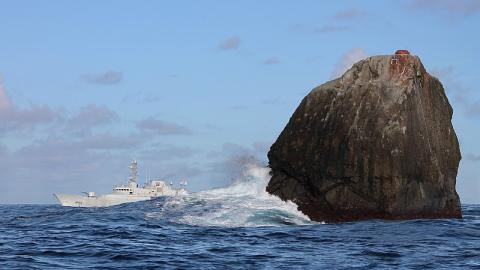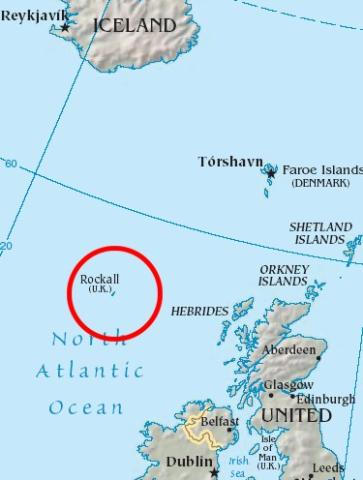[8] Cum autem appropinquāssent ad lītus, minimē poterant aditum invenīre, prae altitūdine rīpae illīus. Erat autem parva et nimis rotunda illa īnsula, quasi ūnīus stadiī. [9] Dē terrā vērō nihil habuit dēsuper, sed petra nūda in modum silicis appāruit. Quantum erat lātitūdinis et longitūdinis, tantae altitūdinis. [10] Cum autem circuīssent nāvigandō illam īnsulam, invēnērunt portum strictum ita ut prōram nāviculae vix capere potuisset, et ascēnsum difficillimum ad ascendendum.
[11] Tum sānctus Brendānus dīxit frātribus suīs: “Expectāte hīc, dōnec revertar ad vōs. [12] Nōn licet vōbīs intrāre sine licentiā virī Deī quī commorātur in hōc locō.” [13] Cum autem venerābilis pater pervēnisset ad summitātem illīus īnsulae, vīdit duās spēluncās—ōstium contrā ōstium—in latere īnsulae contrā ortum sōlis, [14] ac fontem parvissimum, rotundum in modum patulae, surgentem dē petrā ante ōstium spēluncae ubi mīles Chrīstī residēbat; at ubi surgēbat praedictus fōns, statim petra sorbēbat illum.
notes
The island is small, round, and bare (like a loaf of bread). The landing place is barely wide enough to take the prow of the ship (like the place in a loaf of bread when a wedge has been cut out). It is not easy to disembark. Brendan tells the monks to wait in the boat until the local holy man gives them permission to come on shore. Brendan goes off and finds two caves, facing a small spring.
[8] nimis rotunda illa īnsula: the roundness of the island suggests a loaf of bread shared at Holy Communion. Jerome tells us that when Antony visited Paul each hermit was reluctant to take the first piece (Life of St. Paul of Thebes 11).
quasi ūnīus stadiī: the circumference of the island was only about a 1/8 of a mile.
[9] Dē terrā: “of earth," "of soil.”
petra nūda: the “rock” is a famous symbol for Christ and the church.
tantae altitūdinis: = tantum (erat) altitūdinis. The island was as tall as it was wide.
[10] invēnērunt ... potuisset: = invēnērunt portum ita strictum ut prōram nāviculae vix capere potuisset. Compare Matthew 7.14: “How narrow is the gate (Quam angusta porta) and straight is the way that leadeth to life, and few there are that find it!” The sharp incision into the bread-like island may reflect a now defunct part of the ritual of Holy Communion: a slice of the loaf was cut out and inserted into the chalice of wine, commemorating the spear wound inflicted on Christ by the Roman soldier Longinus; the blood from Jesus’ wound was seen as the purifying blood of salvation.
ascēnsum difficillimum ad ascendendum: but the landing was not as difficult as on the Island of Ailbe (ch. 12), perhaps reflecting spiritual progress.
[13] duās spēluncās: In Jerome’s account, Paul of Thebes had only a single cave. The second cave here suggests that Brendan’s visit was preordained, and underscores that there are now two holy men present. It may also reflect a responsory (song) called "Domine Audivi," sung on Good Friday at the moment of Christ’s death: “Christ will be known between two living creatures” (in medio duorum innotesceris animalium).
[14] fontem parvissimum: the water brought out of the by Moses in the desert was identified by St. Paul (the Apostle) with the spiritual sustenance from the rock that is Christ (First Corinthians 10.1-4).
rotundum in modum patulae: the spring is like the paten used at Holy Communion. Its roundness suggests a loaf of bread, especially that central to Holy Communion, and the one shared so famously by St. Antony and Paul of Thebes.
ubi surgēbat praedictus fōns, statim petra sorbēbat illum: the spring is therefore “living water”; compare John 7:37-3: “And on the last and great day of the festivity Jesus stood and cried, saying, ‘If any man thirst, let him come to me and drink.’”
vocabulary
|
appropinquō appropinquāre appropinquavī |
to approach, draw near8 |
|
minimē |
No!, not at all |
|
aditus aditūs m. |
an approach; entryway |
|
prae (prep. + abl.) |
in front of, in the face of (ML); by means of, because of, in view of |
|
altitūdō altitudinis f. |
height |
|
rotundus –a –um |
round, circular, spherical |
|
stadium –iī n. |
a stade (a Greek unit of measurement, equal to 625 Roman feet); a furlong (1/8 of a mile, 660 feet) |
|
dēsuper |
from above9 |
|
petra –ae f. |
a rock, crag |
|
silex silicis n. |
flint |
|
lātitūdō lātitūdinis f. |
breadth |
|
longitūdō longitūdinis f. |
length |
|
altitūdō altitudinis f. |
height |
|
circumeo (circueō ) –īre –iī / –īvī circuitus |
to go around10 |
|
nāvigō nāvigāre nāvigāvī nāvigātus |
to go by ship, sail; to row |
|
portus portūs m. |
harbor |
|
stringō stringere strīnxī strictum |
to draw tight, bind fast; draw (from a scabbard, etc.) |
|
prōra –ae f. |
the extreme forward part of a ship; the prow |
|
nāvicula –ae f. |
boat (ML); (CL) small boat |
|
ascēnsus –ūs m. |
climbing or ascending |
|
licentia licentiae f. |
permission12 |
|
commoror commorārī commorātus |
to linger, stay, live (in a place) |
|
venerābilis –e |
venerable, deserving of respect13 |
|
summitas –ātis f. |
top; surface (OLD 2) |
|
spēlunca spēluncae f. |
cave |
|
ōstium ōsti(ī) n. |
door |
|
contrā |
against; towards, in the direction of (OLD 14a) |
|
ōstium ōsti(ī) n. |
door |
|
contrā |
against; towards, in the direction of (OLD 14a) |
|
ortus ortūs m. |
rising |
|
rotundus –a –um |
round, circular, spherical14 |
|
patula –ae f. |
plate, dish (ML, CL patella –ae f.) |
|
petra –ae f. |
a rock, crag |
|
ōstium ōsti(ī) n. |
door |
|
spēlunca spēluncae f. |
cave |
|
Christus –ī m. |
Christ |
|
resideō residēre resēdī ressus |
to be seated, remain seated; to stand back, stand still |
|
praedīcō praedīcere praedīxī praedictus |
to say beforehand; mention |
|
petra –ae f. |
a rock, crag |
|
sorbeō –ēre –uī |
to drink up |


